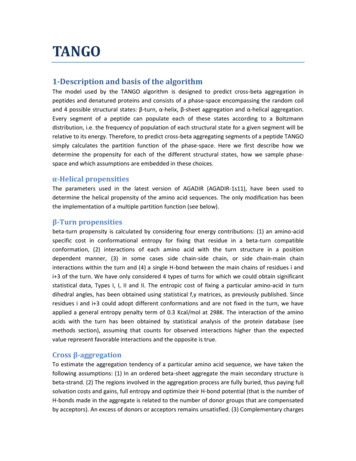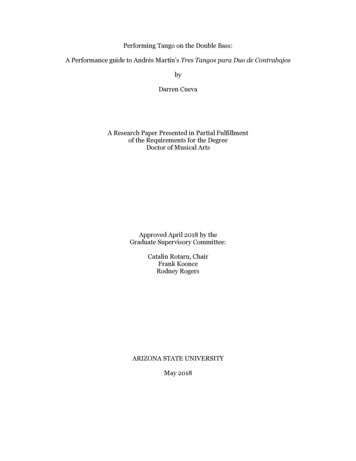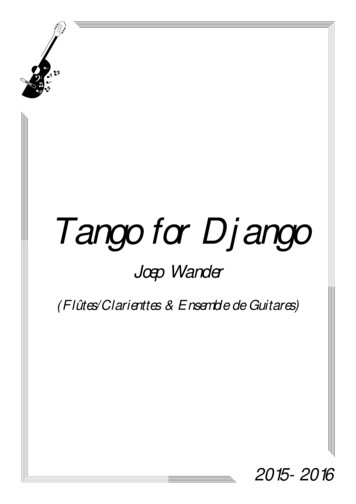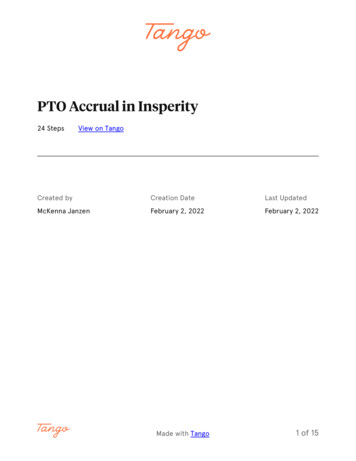
Transcription
TANGO1-Description and basis of the algorithmThe model used by the TANGO algorithm is designed to predict cross-beta aggregation inpeptides and denatured proteins and consists of a phase-space encompassing the random coiland 4 possible structural states: β-turn, α-helix, β-sheet aggregation and α-helical aggregation.Every segment of a peptide can populate each of these states according to a Boltzmanndistribution, i.e. the frequency of population of each structural state for a given segment will berelative to its energy. Therefore, to predict cross-beta aggregating segments of a peptide TANGOsimply calculates the partition function of the phase-space. Here we first describe how wedetermine the propensity for each of the different structural states, how we sample phasespace and which assumptions are embedded in these choices.α-Helical propensitiesThe parameters used in the latest version of AGADIR (AGADIR-1s11), have been used todetermine the helical propensity of the amino acid sequences. The only modification has beenthe implementation of a multiple partition function (see below).β-Turn propensitiesbeta-turn propensity is calculated by considering four energy contributions: (1) an amino-acidspecific cost in conformational entropy for fixing that residue in a beta-turn compatibleconformation, (2) interactions of each amino acid with the turn structure in a positiondependent manner, (3) in some cases side chain-side chain, or side chain-main chaininteractions within the turn and (4) a single H-bond between the main chains of residues i andi 3 of the turn. We have only considered 4 types of turns for which we could obtain significantstatistical data, Types I, I, II and II. The entropic cost of fixing a particular amino-acid in turndihedral angles, has been obtained using statistical f,y matrices, as previously published. Sinceresidues i and i 3 could adopt different conformations and are not fixed in the turn, we haveapplied a general entropy penalty term of 0.3 Kcal/mol at 298K. The interaction of the aminoacids with the turn has been obtained by statistical analysis of the protein database (seemethods section), assuming that counts for observed interactions higher than the expectedvalue represent favorable interactions and the opposite is true.Cross β-aggregationTo estimate the aggregation tendency of a particular amino acid sequence, we have taken thefollowing assumptions: (1) In an ordered beta-sheet aggregate the main secondary structure isbeta-strand. (2) The regions involved in the aggregation process are fully buried, thus paying fullsolvation costs and gains, full entropy and optimize their H-bond potential (that is the number ofH-bonds made in the aggregate is related to the number of donor groups that are compensatedby acceptors). An excess of donors or acceptors remains unsatisfied. (3) Complementary charges
in the selected window establish favorable electrostatic interactions and overall net charge ofthe peptide and net charges near the aggregating region (two residues before or after thechoosen window), disfavor aggregation.Estimation of β-propensity.We have included three energy contributions: a residue-specific cost in conformational entropyfor fixing that residue in a beta-strand conformation and side chain-side chain interactions ofresidue i with residues at positions i 1 and i 2. Formation of a beta-strand requires, in general,less conformational entropy cost than formation of an alpha-helix of equivalent length, becausethe beta-strand region of the Ramachandran plot is larger than the alpha-helical region whilethe depth of the energy well is similar. On the other hand, a single beta-strand does not havemain chain-main chain hydrogen bonds that counteract the loss in conformational entropy. Inthe absence of other contributions the beta-strand will not be populated over the random coil.However, a factor not generally considered is the existence of intra-strand side chain-side chaininteractions that when favorable could promote beta-strand population. The unique side chainsthat are close in space in an extended conformation (beta-strand) are those between positions iand i 2. Residues at positions i and i 1 could also influence the formation of the beta-strandsince they are on average more distant than in the random-coil. This phenomenon has energeticimplications that we denominate (i,i 1) beta-interactions. On this basis, favorable (i,i 1) binteractions reflect repulsions between residues i and i 1 while (i,i 1) beta-unfavorableinteractions reflect attractions of the these side chains when they are not in a beta-strandconformation. These side chain-side chain interactions introduce energetic coupling in the bstrand-coil transition, producing some cooperativity. The entropic cost of fixing a particularaminoacid in beta dihedral angles, has been obtained using statistical f,y matrices, as previouslypublished.The other two terms participating in the equation, interaction between residues i,i 1 and i 2,are relative to the energy contribution of side chain-side chain interactions. They have beendetermined using a mean-force potential.Desolvation costs of aggregated segments.As explained above we assume that the residues forming the core of the ordered aggregatemust be fully buried. This implies full desolvation and minimum degrees of freedom. Theenergetic cost of burying a sequence stretch is defined by the following equation:were Dsolv and Dvdw are obtained from the FOLD-EF forcefield (Reference) assuming maximumburial. DHbond is equal to the number of H-bonds made by the buried segment multiplied bythe H-bond contribution (the same value used in AGADIR1s). The number of H-bonds is equal tothe number of donors, or acceptors, in the polypeptide chain that could pair with an acceptor ordonor, respectively. For the backbone this is always 2 per residue, and for the side chains wejust count the total number of donors and acceptors and we take the minimum number of thetwo. In the case of Pro we consider that if it is N-terminal to the segment we loss only one
backbone H-bond, while if it is C-terminal we loss two. A Pro inside a segment is penalized by 10Kcal/mol.Dentropy assumes full entropy cost and is the sum of the main chain entropy due to theresidues being in an extended conformation and side chain entropy (as described by ABGYAN).The model used to calculate the electrostatic contribution to helix stability was previouslydescribed in Viguera, Lacroix, Serrano). In the following paragraph we describe how electrostaticcontributions Delectrostatic to beta-aggregates are computed.Electrostatic contribution.The electrostatic interactions obviously change with the degree of ionization and consequentlywith the pH of the solution, while the pKa of ionizable groups in a peptide change from theirstandard values depending on the electrostatic environment. In TANGO we considered allelectrostatic interactions (this involves charged side chain groups, free N-terminal and Cterminal main chain groups, and the succinyl blocking group if the peptide is succinylated) tocompute the electrostatic environment of the amino acids in the random coil and in helicalsegments, taking into account the ionic strength, temperature and the pKa (see below).TANGO distinguishes between charges in the segment under consideration (internal charges)which are considered fully buried, charges within two residues outside the N-or C-terminus ofthe segment (neighbouring charges) which are considered solvent exposed and the rest of thecharges in the polypeptide chain (external charges). External charges are also considered to besolvent exposed but in addition their contribution is corrected with chain length. For buriedcharges we use a dielectric constant of (332/(8.8 * exp(-0.004314 * (temp-273.0)))), while forexposed charges it is 332/(88 * exp(-0.004314 * (temp-273.0))).The net charge for the segment under consideration plus its neighbouring residues is calculatedassuming an average distance between charges in the aggregate of around 5A. For the rest ofthe polypeptide chain TANGO calculates the net charge and divide it by the number of residuesintroducing a higher average distance for longer polypeptide chains.There are two types of electrostatic interactions: repulsive interactions due to a net charge andattractive interactions due to compensated charges. The latter one has been introduced toreflect that on average some of the compensated charges will make salt bridges and thuscontribute to the stability of the aggregate. In the case of the attractive compensated chargeswe correct the favorable electrostatic interaction calculated by dividing it by 3. This arbitrarycorrection factor is introduced since as explained above this term reflects the formation ofinternal salt bridges which of course cannot be formed by all compensated charges.α-Helix aggregation.Some peptides and proteins aggregate in a helical conformation. This is typically observed inproteins with a tendency to form coiled-coil structures or Leu-zippers (references). Sinceformation of dimers or higher order helical aggregates will compete with beta-sheet aggregationwe have included this structural state in the TANGO algorithm in a very simple manner. As for
beta-sheet aggregation we assume full burial upon aggregation, but only for one face of thehelical structure. Thus, we assume than in a helical aggregate residues i,i 1, i 4,i 5, i 8, i 9 etcwill be fully buried. For those residues we applied the same considerations as for burial ofresidues in beta-sheet aggregates. The energy required to fold the segment into a helicalconformation, however, is directly derived from AGADIR.pH, ionic and temperature dependenceThe effect of pH, temperature and ionic strength on electrostatic interactions was taken intoaccount as described in AGADIR2-1s11. Similarly the dependence of entropy, H-bonds andhydrophobic interactions on temperature and ionic strength are taken into consideration asdescribed in AGADIR2-1s11.Multiple partitions Function.To calculate a partition function a multiple window approximation as used for the AGADIRmsalgorithm and described in Munoz et al. has been implemented. Basically we consider thatoverlapping windows and windows up to two residues from the beginning or the end of thewindow been analyzed can compete. Windows separated by more than two residues from theone been considered are not included in the partition function.A simplification is that we do not consider aggregation intermediates. We consider aggregatesas a single molecular species or structural state in competition with b-turn and a-helicalconformations again for the sake of simplifying the partition function. This simplification can betranslated in the assumption that the aggregating segment has an infinite concentration, or inother words, that once formed it immediately aggregates with infinite association constant.Since in reality the aggregation kinetics and the extent of aggregation will depend on theconcentration of the peptide as well as of its association constant, this means that theaggregation probabilities we are obtaining are only relative. Thus they allow comparison insidethe same polypeptide chain, or with mutants of the polypeptide chain, but not betweendifferent polypeptide chains.Third, like in the multiple window approximation of AGADIR we have assumed that there is noenergetic coupling between the two non-overlapping segments (independent of theirconformation) that are simultaneously present in the same molecule. This assumption seemsrather reasonable for monomeric peptides in which there are no long or medium rangeinteractions. Finally, we assume that all possible states can coexist by pairs in the samepolypeptide molecule, that is an aggregate can have a helical segment as long as it is out of theaggregated segment (there is experimental evidence for this, like in lysozyme were helicalregions still persist in the amyloid aggregate).Under these assumptions and the definition of the random coil state as those conformationswhich are not helical, or turn or involved in aggregation, the multiple sequence partitionfunction of one window becomes the sum of the statistical weights for all the possiblecombinations of structured segments plus the statistical weight for the random coil state (the
set of molecular conformations which do not include any structured segment). The weight forthe random coil is 1 (arises from the product of the weights of all the residues in the random coilstate).2-Input and output formatsRunning TANGO from the command line.1. Open a command line window and go to the directory where you have put the executable.2. Call tango as in the following example (use spaces, not tabs):Tango P05100 ct "N" nt "N" ph "7.4" te "303" io "0.05" seq "DNEWGYIAYHVSQDP"ct: Protection at the C-terminus: can be N for no or Y for amidatednt: Protection at the N-terminus: can be N for no, A for acetylated or S for succinilated.ph: pHte: Temperature in Kelvinio: Ionic strengthRunning TANGO with an input file.To be run with an input file, Tango needs a text file that can have any name the user wants aslong as it has less than 25 characters. Inside the file the user can place as many sequences to beanalyzed as long as the number is less than 1000 sequences.The format of the sequences to be run is as follows:Name Cter Nter pH Temp Ionic SequenceName name of the sequence (less than 25 characters)Cter status of the C-terminus of the peptide (amidated Y, free N)Nter status of the N-terminus of the peptide (acetylated A, succinilated S and free N)pH pHTemp temperature in KelvinIonic ionic strength in Msequence sequence of the peptide in one letter code.ExampleSup1 N N 7 298 0.1 AMAPVLYLQDKSSsup2 N N 7 298 0.1 AMASVLYLQDKSSsup3 N N 7 298 0.1 AMAPVLYLQSKSSsup4 N N 7 298 0.1 AMASVLYLQSKSSsup5 N N 7 298 0.1 AMAPVLYLQPKSSsup6 N N 7 298 0.1 AMARVLYLQDKSSsup7 N N 7 298 0.1 AMAPVLYLQRKSSThe programme window first asks if the user wants to have the aggregation content by residue.If the user types Y, then he/she will get a file for each sequence in the text file.
TANGO output.The output of TANGO is in text format with the extension .out. You will get two classes ofoutputs. One with the name of the file you run that will contain the average aggregation perresidue for every sequence you had in your file. The other will be a series of files with the namesof the sequences you run that will contain the prediction at the residue level.Those files will have the following columns:Sequence NumberAmino acid in one-letter codePercentage of -strand conformationPercentage of -turn conformationPercentage of -helical conformationPercentage of AggregationPercentage of Helical Aggregation.Please be aware that the latest is calculated independently of the first four and therefore youcould get a number higher than 1 if you sum the 5 columns.Example of sequence .000.000.000.000.00
0.00,0.00,0.00,0.00,0.00,0.00,0.00, 0.000.00, 0.000.00, 0.000.00, 0.000.00, 0.000.00, 0.000.00, 0.000.00, 0.000.00, 0.000.00, 0.000.00, 0.000.00, 0.000.00, 0.000.00, 0.000.00, 0.000.00, 0.000.00, 0.000.00, 0.000.00, 0.000.00, 0.000.00, 0.000.00, 0.000.00, 0.000.00, 0.000.00, 0.006.27, 0.006.27, 0.0011.61, 0.0011.93, 0.0011.93, 0.0011.69, 0.008.01, 0.007.08, 0.006.80, 0.000.00, 0.004.17, 0.004.39, 0.004.39, 0.004.39, 0.004.53, 0.005.02, 0.0012.27, 0.0064.25, 0.0068.13, 0.0070.91, 0.0070.91, 0.0070.91, 0.0067.35, 0.0062.97, 0.00
0.000.000.000.003-Interpretation of the dataThe user must be aware that TANGO considers that the polypeptide sequence is fullydenatured and solvent exposed. Thus a globular protein with high stability could have astrong aggregating sequence inside and will aggregate little if it folds fast and underdiluted conditions, while the same sequence in a small unfolded peptide will readilyaggregate.Strong aggregation regions in globular proteins could be problematic if the protein isexposed to denaturing conditions, suffers a point mutation that destabilizes it or is atsufficient high concentration that the small percentage of the denatured form can startaggregation.The user must be aware that aggregation is a concentration dependent process andtherefore sequences that at 0.1 mM will be soluble they will precipitate at 1 mM.TANGO assumes a fixed concentration of 1 mM (We have other versions withconcentration and stability dependence which are available).As a rule of the thumb any segment with an aggregation tendency above 5% over 5-6residues is a potential aggregating segment.
TANGO 1-Description and basis of the algorithm The model used by the TANGO algorithm is designed to predict cross-beta aggregation in peptides and denatured proteins and consists of a phase-space encompassing the random coil and 4 possible structural states: β-turn, α-helix, β-sheet aggregation and α-helical aggregation. .










